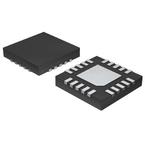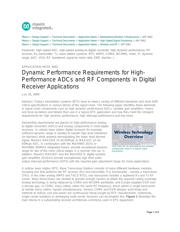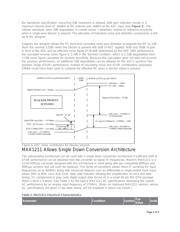
Click here for an overview of the wireless
components used in a typical radio
transceiver.
Maxim > Design Support > Technical Documents > Application Notes > Basestations/Wireless Infrastructure > APP 3062
Maxim > Design Support > Technical Documents > Application Notes > High-Speed Signal Processing > APP 3062
Maxim > Design Support > Technical Documents > Application Notes > Wireless and RF > APP 3062
Keywords: high-speed ADC, high-speed analog-to-digital converter, high dynamic performance, RF
receiver, Rx, transmitter, Tx, base station systems, BTS, AMPS, CDMA, WCDMA, mixer, IF, dynamic
range, AGC, VGA, RF, baseband, signal-to-noise ratio, SNR, blocker, c
APPLICATION NOTE 3062
Dynamic Performance Requirements for High-
Performance ADCs and RF Components in Digital
Receiver Applications
Jun 15, 2004
Abstract: Today's basestation systems (BTS) have to meet a variety of different standards and must fulfill
critical specifications in various blocks of the signal chain. The following paper identifies these demands
in signal chain components such as high dynamic performance ADCs, variable gain amplifiers, mixers
and local oscillators and details their use in a typical BTS application and how they meet the stringent
requirements for high dynamic performance, high intercept performance and low noise.
Demanding requirements are placed on high-performance analog-
to-digital converters (ADCs) and analog components in most digital
receivers. In cellular base station digital receivers for example,
sufficient dynamic range is needed to handle high-level interferers
(or blockers) while properly demodulating the lower level desired
signal. Maxim's MAX1418 15-bit 65Msps or MAX1211 12-bit
65Msps ADC, in combination with the MAX9993 2GHz or
MAX9982 900MHz integrated mixers, provide exceptional dynamic
range for two of the most critical stages in a receiver line-up. In
addition, Maxim's MAX2027 and the MAX2055 IF digital variable
gain amplifiers (DVGAs) provide exceptionally high third order
output intercept performance (OIP3) with the required gain adjustment range for many applications.
A cellular base station (BTS: Base Transceiver Station) consists of many different hardware modules
including one that performs the RF receiver (Rx) and transmitter (Tx) functionality - namely a transceiver
(TRx). In the older analog AMPS and TACS BTSs, one transceiver handles a duplexed Rx and Tx RF
carrier. Many transceivers are needed to provide enough carriers to obtain the required calling coverage.
Analog technology is being replaced by CDMA and WCDMA worldwide, and Europe adapted GSM over
a decade ago. In CDMA, many callers utilize the same RF frequency, which allows a single transceiver
to handle many callers' signals simultaneously. Various CDMA and GSM designs exist today and
methods to reduce cost and power are continuously being sought by BTS manufacturers. Optimizing
single-carrier solutions or developing multi-carrier receivers can accomplish this. Figure 1 illustrates the
main blocks in a subsampling receiver architecture commonly used in BTS equipment.
Page 1 of 9








